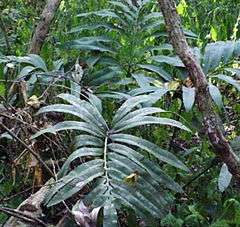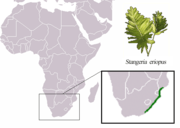Stangeria
| Stangeria | |
|---|---|
 | |
| Stangeria eriopus in coastal lowland forest, South Africa | |
| Scientific classification | |
| Kingdom: | Plantae |
| Division: | Cycadophyta |
| Class: | Cycadopsida |
| Order: | Cycadales |
| Family: | Stangeriaceae |
| Genus: | Stangeria T.Moore |
| Species: | S. eriopus |
| Binomial name | |
| Stangeria eriopus (Kunze) Baillon | |
Stangeria eriopus is a cycad endemic to southern Africa It is the sole species in the genus Stangeria, most closely related to the Australian genus Bowenia, with which it forms the family Stangeriaceae. IUCN Red List Category & Criteria: Vulnerable, mainly due to habitat loss and over-exploiting for traditional medicine. It is listed under CITES Appendix I / EU Annex A, and CITES prohibits international trade in specimens of this species except when the purpose of the import is not commercial, for instance for scientific research.
Stangeria eriopus has pinnately-veined, fern-like leaves that distinguish it from all other cycads. The species occurs as two variable forms or varieties. The forest form, growing in regions with higher rainfall, is characterized by large, wide leaves that can reach up to 2 m in length. The grassland form, growing in regions subject to annual fire and drought, has shorter leaves with a thicker cuticle that may only be 30 cm long. In both varieties the petiole comprises one third to one half of the overall leaf length.
Stems are completely subterranean and the root is shaped like a carrot. As in other cycads, S. eriopus forms coralloid roots. These are specialized, plagiotropic (sideways-growing) roots housing colonies of cyanobacteria that fix nitrogen, much like the roots of legumes.
S. eriopus reaches maturity at 5–7 years of age, and has stalked cones as reproductive organs. As is typical of cycads, the species is dioecious, meaning that male and female cones are borne on different plants. The cones are insect-pollinated, giving off a faint odor to attract beetle pollinators. At maturity they fall apart to reveal the seeds, which are 2–3 cm in length.
The binomial name comes from the Greek prefix erio-, meaning "woolly", and suffix -pus, "footed", referring to the woolly petiole bases. It was named in honour of William Stanger, a former surveyor-general of Natal. Common names includes Natal Grass Cycad, Hottentot's Head and Stangeria.
Distribution

It is native to the east coast of South Africa and southern Mozambique. It is found within 50 km, but not closer than 2 to 3 km, from the sea. This species of cycad is adaptable and is found in many habitats, from closed forest to grassland, but it is under increasing threat from habitat loss and unsustainable harvesting for traditional medicinal purposes.
References and external links
- Donaldson (2003). "Stangeria eriopus". IUCN Red List of Threatened Species. Version 2006. International Union for Conservation of Nature. Retrieved 11 May 2006.
- Whitelock, Loran M. (2002). The Cycads. Portland OR: Timber press. ISBN 0-88192-522-5.
- Tuckley, R. (1999). "A new significance for Stangeria?". The Cycad Newsletter. 22 (4): 11–14.
- Osborne R, Grove A, Oh P, Mabry TJ, Ng JC, Seawright AA (July 1994). "The magical and medicinal usage of Stangeria eriopus in South Africa". J Ethnopharmacol. 43 (2): 67–72. doi:10.1016/0378-8741(94)90005-1. PMID 7967657.
- Vorster, P.; Vorster, E. (March 1985). "Stangeria eriopus". Encephalartos. 2: 1–11.
- Douwes, E.; Gillmer, M.; Mattson, M.; Dalzell, C. (2004). "Vegetative propagation of Stangeria eriopus from leaf material". Encephalartos. 80: 28–30.
- The Cycad Pages: Stangeria eriopus
- Cycad Society of South Africa: Stangeria eriopus
